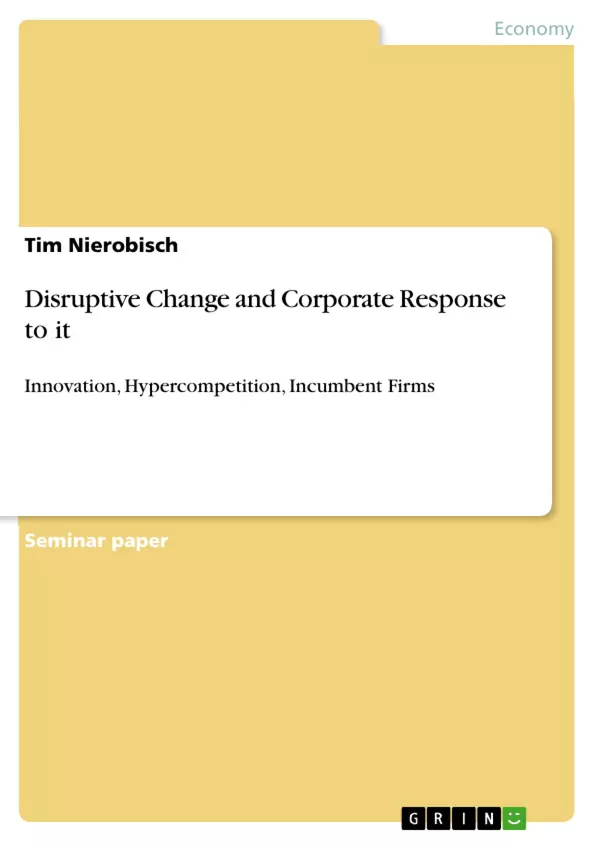This paper addresses the understanding of disruptive change by highlighting the problems that arise when incumbent firms face disruptive innovations within their markets. In order to generate a new understanding of the competition that arises through disruptive change, disruptive innovations are linked to the concept of “hypercompetition” made by Richard A. D’Aveni. This concept implies the possibility to disrupt the market by implementing a new strategic orientation called the new “7-S Framework”. However this implies the necessity of reorganizing the incumbent firm. A possible approach is introduced. With this paper the author tries to identify a possible method to become disruptive for incumbent firms. The topic is “disruptive change and corporate response to it”.
Inhaltsverzeichnis (Table of Contents)
- Introduction
- Methodology
- An overview of the phenomenon "disruptive change"
- Defining disruptive change
- The pathway of disruptive innovation
- Why incumbent companies fail to cope with disruptive change
- What does disruptive change lead to?
- The concept of hypercompetition and linkages to disruptive change
- The new 7-Ss as a strategic orientation for incumbent firms
- Reorganizing the incumbent firm in order to create abilities to become disruptive
- Conclusion
Zielsetzung und Themenschwerpunkte (Objectives and Key Themes)
This paper aims to understand disruptive change by examining the challenges faced by established companies when confronted with disruptive innovations within their markets. It seeks to develop a new understanding of the competitive dynamics arising from disruptive change by connecting disruptive innovations to the concept of "hypercompetition" proposed by Richard A. D'Aveni. This concept suggests the possibility of disrupting the market by adopting a new strategic approach, the "New 7-S Framework". However, this requires organizational restructuring of the incumbent firm. The paper explores a potential method for incumbent companies to become disruptive themselves.
- The phenomenon of disruptive change and its impact on incumbent firms
- The concept of hypercompetition and its relationship to disruptive change
- The "New 7-S Framework" as a strategic response to disruptive change
- The challenges of organizational restructuring for incumbent firms
- Methods for incumbent firms to become disruptive forces themselves
Zusammenfassung der Kapitel (Chapter Summaries)
The paper begins by defining disruptive change and exploring its causes. It examines how established companies often fail to adapt to this changing landscape. This section includes a review of the literature on disruptive change and its impact on industries like the photo and hard disk drive sectors.
The next chapter delves into the concept of hypercompetition, linking it to the phenomenon of disruptive change. It analyzes how disruptive innovations can reshape competition and explores the "New 7-S Framework" as a strategic response. The chapter discusses how this framework can be applied to help incumbent firms adapt and compete in this new landscape.
The paper continues by examining the process of reorganizing incumbent firms to embrace disruptive change. It explores strategies and methods that can be employed to make companies more dynamic and responsive to innovation.
Schlüsselwörter (Keywords)
The core focus of this paper is on disruptive change, innovation, hypercompetition, organizational structure, and strategic responses to the challenges posed by a rapidly evolving marketplace. It emphasizes the importance of understanding and navigating the impact of disruptive innovations on incumbent firms, seeking to equip these companies with the necessary tools and strategies to become disruptive forces themselves.
- Quote paper
- Tim Nierobisch (Author), 2009, Disruptive Change and Corporate Response to it, Munich, GRIN Verlag, https://www.grin.com/document/162517



